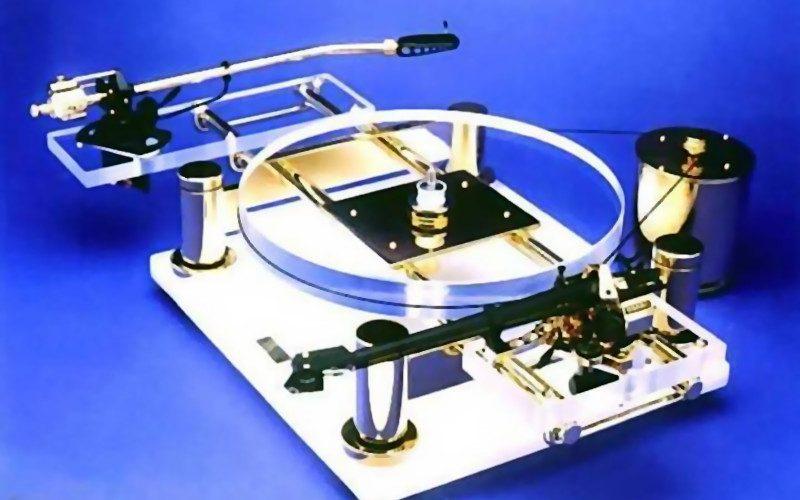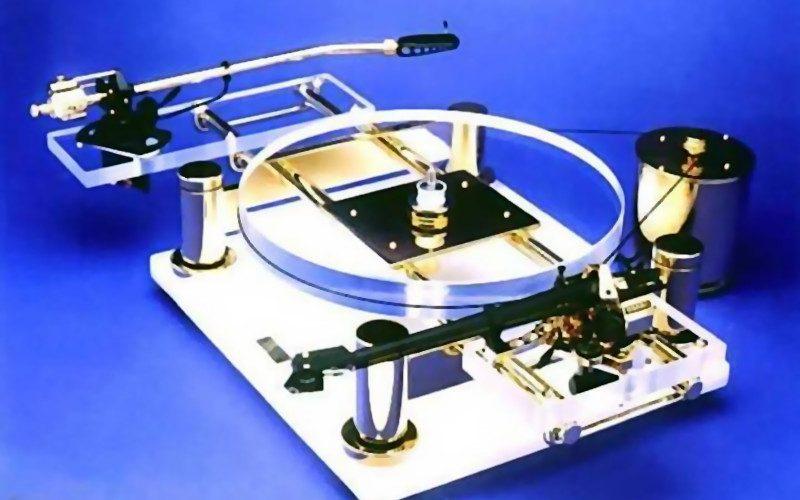


'Gorgeous.' That's the word I kept hearing, every time someone noticed the Quasar LE turntable in for review. And one of the first to utter it was the owner of a Michell Orbe, itself no canine. What these individuals cooed over is one of the prettiest LP spinners to come along since the first Oracle. And that's one hell of an antecedent.
It's not that farfetched, either, as the Quasar is virtually 'plinthless' like the Oracle, as well as most Michells and a few other belt-driven alternatives to the more conventional Linns, Roksans and the like. The complete works are there for all to see, with four spring-filled pillars supporting a frame which carries the bearing/platter assembly and the armboard. The motor itself, situated completely 'outboard', is detached as much as is possible without defying reality; it's physically linked to the Quasar only by the belt. This isolationism, though, presents a minor problem, as the Quasar doesn't arrive with a template to help you locate the motor precisely. Which I'll get to later. But first, Why The Quasar Stops People Dead In Its Tracks.
Sound By Design sent the base model to us for the review, the £1780 Quasar LE, fitted with a Helius tonearm and needing no setting up on my part. But I did watch as Predrag Savic unpacked it and noted that the device's simplicity and elegance combined not just to make set-up straightforward and intuitive, but to work at proving the adage that if something looks right, it is right. It's doubtful whether or not there's any truth to that belief, since the worlds of hi-fi, motoring, etc, are full of aesthetic triumphs which are functional failures, like Lancia Gammas and Strathearn turntables. But the Quasar LE looks as right as it gets, with a cylinder at each corner, connected by transverse bars. To these are fitted a pair of rods which make this turntable so truly user-friendly: the rods support the armboard and bearing, both of which can be moved with ease to allow the Quasar to support two arms, 12in arms, whatever the owner cares to match to the basic structure.
It's deceptively large, especially if the standalone motor assembly is relegated to the importance of an afterthought when you do your planning. In basic, single-arm form, the Quasar has a 545x325mm (WxD) footprint, and you must allow another 300mm or so for the motor unit. If you opt for two arms and the width increases to 370mm because both arms are mounted so as to extending past the ends of the baseboard and look like they're floating. But it's so damned svelte that it never seems massive, even in double-limb form, the chrome and brass and acrylic blending together with surprising harmony. Even the deluxe versions with gold plated parts and marble-llok base plates remain tasteful and understated, despite suffering a verbal description which could apply to the bathroom in an upscale bordello.
Nothing about the Quasar's design philosophy is bizarre, outre, odd or jarring. The external motor unit is an obvious example. By relegating it off-campus, there is simply no way that motor noise or vibration can interfere with the deck itself. If isolating the motor from the turntable was a major part of the original impetus for creating belt-drive decks in place of the once dominant idler-drive deck, then Quasar has taken the concept as far as it can go. We discussed the notion of supplying the Quasar with a spacer or template to help the customer to locate the motor relative to the deck (the owner's manual suggests a not-sufficiently-precise-by-my-reckoning '225-230mm' from spindle to pulley), and then to centre it. But it then occurred to me that Savic was being polite by ignoring my initial stupidity: any sort of frame or template or spacer used to position the motor relative to the deck would violate the near-total isolation offered by the present hands-off set-up. Which implies that, should the company ever produce a set-up jig, it would be used only during the installation, then removed.
Quasar's aforementioned mix of materials isn't purely aesthetic. The baseboard is an acrylic laminate, the main chassis is brass, acrylic platters and armboards have been politically approved for years (beloved for its resemblance to the behaviour of LP vinyl) - all are materials which have been chosen to complement each other according to their damping and resonant properties. Nothing new here; it's just common sense and a readily admitted respect for revered designs from the past. So, too, then, the use of a record clamp, a slightly undersized spindle to 'decouple' it from the LP, a suspension so easy to adjust that it seems to be nearly self-levelling and a chassis with enough mass to obviate the need for near-neurotic attention to tonearm cable trimming. The assembly weighs 18kg, a substantial amount for something so deliciously skeletal.
Other details include the housing of the motor in a 3.3kg solid brass cylinder, a stepped pulley to allow 33 and 45rpm playback, a non-inverted bearing, an armboard that can be changed simply by removing four screws and the absence of a dust-cover (why hide all this beauty? is probably the argument against providing a dust barrier...). Suspension adjustment involves no more than turning the caps on the four pillars, while speed change requires simply moving the belt from one of the pulley steps to the other. But the belt is the major area of criticism, and I don't mean trying to ensure the correct tension without the aid of a set-up template.
Let's not mince words here: I haven't seen such erratic behaviour from a simple round cross-section 'rubber band' since the days of the unlamented Oak. No matter what I tried, and that included using three different belts, I couldn't get the thing to stay in one place. It would ride up and down the sides of the platter, a visual betrayal, so to speak, given the otherwise near-perfect aesthetics of the Quasar. I did everything I could to ameliorate its wanderlust, especial setting the motor assembly at different heights, a millimetre at a time, to exploit different areas of the 30mm thick platter's vertical surface. Dead centre, riding near the top, riding near the lower edge - nothing would alter its aberrant behaviour.
Did it matter? Given that two different strobe discs showed sublime speed stability, and given that material with a particular vulnerability to wow and flutter revealed no sonic weaknesses from the Quasar in this department, it's arguable that unstable, 'unhorizontal' behaviour from a belt may cause no ill effects whatsoever. On the other hand, if something should look right to be right, then the quivery Quasar belt compromises the deck's glorious styling in the way that a festering cold sore on her upper lip would kinda ruin a
The cure? Simple: the Quasar platter should wear a groove around its circumfrence (two grooves, actually, to accommodate both speeds) to 'capture' the current choice of belt. Either that, or the company should try a different pulley which accepts flat cross-section belts. Savic didn't go into denial mode or start calling me 'anal', but I must admit that his relative lack of concern about this issue worried me as much as the belt's erratic movement.
Read more on Page 2

But enough bitching: this deck is one sweet-sounding, coherent, dynamic performer. With the luscious Helius in place, and Savic's Goldring replaced with a Lyra Clavis for the listening sessions, I fed the Quasar front-end into the Trilogy 905 head-amp, the GRAAFiti WFB TWO pre-amp, GRAAFiti 5050 power amp and Quad ESL63s. Music? Lots of singles, especially a delightfully scratchy copy of Bud Flanagan's 'Who Do You Think You're Kidding, Mr. Hitler?', a bunch of recent MoFi Anadisc 200s, the awesome
Talk about more-ish. The Quasar, although probably the quietest deck I've heard this side of 2000, approaches the conundrum of playing LPs in the digital era by using a rather different approach than, say, the Michells, the SMEs or Max Townshend's stunning Rock and its derivatives. These turntables, to elicit a groan, turn the tables on CD by being just as clean and precise as digit-heads expect CD but not LP to be, and they do it without forsaking the glories of analogue. The Quasar doesn't even attempt to emulate those turntables with their near-laboratory-standard behaviour. Instead, the Quasar uses its quietness more as proof that LPs needn't seem to throw out higher noise floors than CDs than to suggest that LPs
So, working from a position neither of defensiveness nor of digit-envy but of confidence in its medium, the Quasar simply revels in 'analogueness'. It's lush, it's fat, it's warm, it's involving. Even squeaky-clean, modern LPs taken from digital originals sounded more ear-friendly than their CD equivalents. (Which begs the question: Should new LPs sport a three-letter-code of 'DDA' or 'DAA' if they started out digitally?)
Something about the Quasar suggests 'middle ground', moderation, tranquility. The soundstage, while as precise and three-dimensional as is required, is not as Cinemascopically grand as that of the Michell Gyro-Dec. Bass is extended and controlled, but less tightly damped as that of the Garrard 401. Treble? Sweet as sugar, but without the ultimate attack. And still the Quasar represents a sane approach to analogue playback which will satisfy an LP-playing hard-core, while not alienating listeners suckled on CD.
Perceived value? An absolute bargain, especially if you never expected to have a piece of sculpture thrown in for free. It looks as fresh and clean and modern (and therefore ironic) as did the Transcriptor which Alex used in